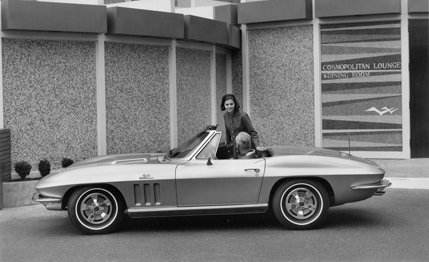Higher-rate front and rear springs are fitted, along with a 7/8-inch stabilizer bar at the front and a 3/4-inch bar at the rear. The half-shafts and U-joints are shot-peened, and are constructed of stronger stuff than on the 327, and there’s been an increase in both coolant and lubricant capacity. The 427 can only be ordered with the “Muncie” four-speed transmission and Chevrolet’s “Positraction” limited-slip differential. All prudent precautions, which underline the massive thrust available from this new powerplant.
In addition to our 425-bhp test car, Chevrolet also offers a 390-bhp version of the 427-cu. in. engine. This engine has different heads with smaller intake ports, and a smaller-section intake manifold which is cast-iron, as opposed to aluminum on the 425. It also has hydraulic lifters instead of the mechanical lifters in the hotter engine. Both have single four-barrel Holley carburetors, and there’s no difference in exterior appearance, save for various emlems and decals and things. The hydraulic-lifter engine develops 390 bhp at 5400 rpm, and 465 lbs/ft of torque at 3600. It’s not what you’d call puny, by any stretch of the imagination. In fact, without a watch or a measured quarter-mile, the average driver would have a hard time telling the difference — except for a smoother idle and less mechanical noise.
|
|
The interior appearance has no significant changes either. It is still roomy, comfortable, and very well sealed against wind and weather. The seats have a broad range of adjustment, and though they’re not the super-buckets of a Ferrari GTB, they are pleasant to sit in for long drives. The back rests still are not adjustable, and this is too bad, especially now that virtually every medium-to-high-priced sedan in the GM line-up offers that feature.
The driving controls and small switches are just fine. The steering wheel telescopes in and out, and this, combined with the seat adjustment, makes it possible to have a pretty decent driving position. Our test car had power brakes and power steering, and we were grateful for both. GM’s Saginaw Steering Gear Division has worked hard to provide a normal American-style power steering gear that has some feel and accuracy, and they’ve done a good job. The Mercedes-Benz system was their performance-target and though the Corvette doesn’t measure up quite to that standard (you’re still turning a valve, instead of the wheels), it is superior to any other American car. The power brakes are even better. They’re smooth, free from any grabbiness or directional instability, and they do get it stopped! Even bringing it down from speeds in the 130-140 bracket without any sweat.
|
|
Driving the car on an unrestricted proving ground road is a memorable experience. It accelerates from zero to 100 in less than eleven seconds — faster than a lot of very acceptable cars can get to sixty — and is so smooth and controllable in the three-figure speed ranges that it all becomes sort of unreal. In fact, in those circumstances it’s pretty hard to tell anything about the car at all, except that it goes like bloody hell and stops and steers without scaring you.
View Photos
View Photos


Leave a Reply